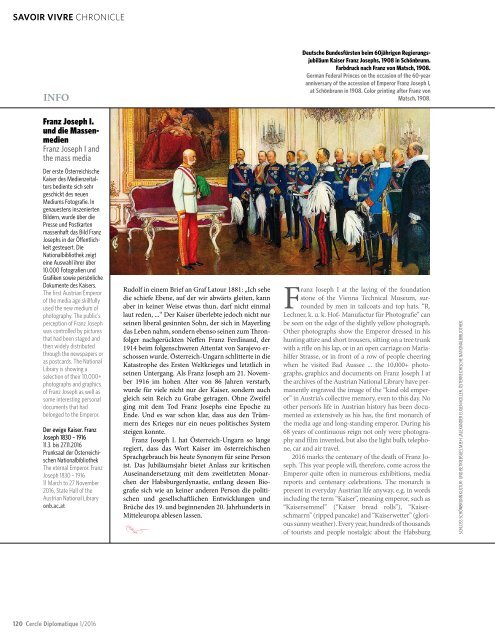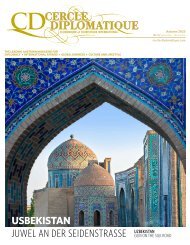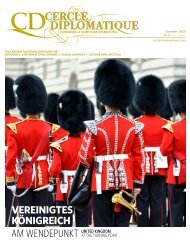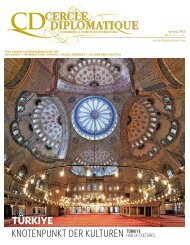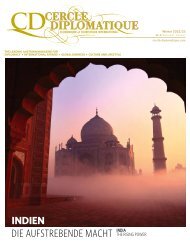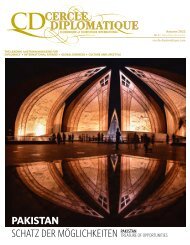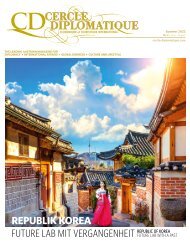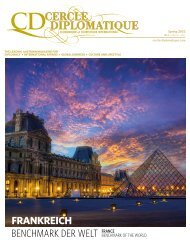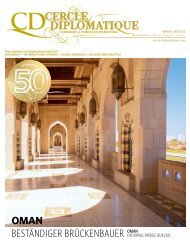CERCLE DIPLOMATIQUE - issue 01/2016
CD is an independent and impartial magazine and is the medium of communication between foreign representatives of international and UN-organisations based in Vienna and the Austrian political classes, business, culture and tourism. CD features up-to-date information about and for the diplomatic corps, international organisations, society, politics, business, tourism, fashion and culture. Furthermore CD introduces the new ambassadors in Austria and informs about designations, awards and top-events. Interviews with leading personalities, country reports from all over the world and the presentation of Austria as a host country complement the wide range oft he magazine.
CD is an independent and impartial magazine and is the medium of communication between foreign representatives of international and UN-organisations based in Vienna and the Austrian political classes, business, culture and tourism. CD features up-to-date information about and for the diplomatic corps, international organisations, society, politics, business, tourism, fashion and culture. Furthermore CD introduces the new ambassadors in Austria and informs about designations, awards and top-events. Interviews with leading personalities, country reports from all over the world and the presentation of Austria as a host country complement the wide range oft he magazine.
You also want an ePaper? Increase the reach of your titles
YUMPU automatically turns print PDFs into web optimized ePapers that Google loves.
SAVOIR VIVRE CHRONICLE<br />
INFO<br />
Deutsche Bundesfürsten beim 60jährigen Regierungsjubiläum<br />
Kaiser Franz Josephs, 1908 in Schönbrunn.<br />
Farbdruck nach Franz von Matsch, 1908.<br />
German Federal Princes on the occasion of the 60-year<br />
anniversary of the accession of Emperor Franz Joseph I,<br />
at Schönbrunn in 1908. Color printing after Franz von<br />
Matsch, 1908.<br />
Franz Joseph I.<br />
und die Massenmedien<br />
Franz Joseph I and<br />
the mass media<br />
Der erste Österreichische<br />
Kaiser des Medienzeitalters<br />
bediente sich sehr<br />
geschickt des neuen<br />
Mediums Fotografie. In<br />
genauestens inszenierten<br />
Bildern, wurde über die<br />
Presse und Postkarten<br />
massenhaft das Bild Franz<br />
Josephs in der Öffentlichkeit<br />
gesteuert. Die<br />
Nationalbibliothek zeigt<br />
eine Auswahl ihrer über<br />
10.000 Fotografien und<br />
Grafiken sowie persönliche<br />
Dokumente des Kaisers.<br />
The first Austrian Emperor<br />
of the media age skillfully<br />
used the new medium of<br />
photography. The public‘s<br />
perception of Franz Joseph<br />
was controlled by pictures<br />
that had been staged and<br />
then widely distributed<br />
through the newspapers or<br />
as postcards. The National<br />
Library is showing a<br />
selection of their 10,000+<br />
photographs and graphics<br />
of Franz Joseph as well as<br />
some interesting personal<br />
documents that had<br />
belonged to the Emperor.<br />
Der ewige Kaiser. Franz<br />
Joseph 1830 – 1916<br />
11.3. bis 27.11.2<strong>01</strong>6<br />
Prunksaal der Österreichischen<br />
Nationalbibliothek<br />
The eternal Emperor. Franz<br />
Joseph 1830 – 1916<br />
11 March to 27 November<br />
2<strong>01</strong>6, State Hall of the<br />
Austrian National Library<br />
onb.ac.at<br />
Rudolf in einem Brief an Graf Latour 1881: „Ich sehe<br />
die schiefe Ebene, auf der wir abwärts gleiten, kann<br />
aber in keiner Weise etwas thun, darf nicht einmal<br />
laut reden, ...“ Der Kaiser überlebte jedoch nicht nur<br />
seinen liberal gesinnten Sohn, der sich in Mayerling<br />
das Leben nahm, sondern ebenso seinen zum Thronfolger<br />
nachgerückten Neffen Franz Ferdinand, der<br />
1914 beim folgenschweren Attentat von Sarajevo erschossen<br />
wurde. Österreich-Ungarn schlitterte in die<br />
Katastrophe des Ersten Weltkrieges und letztlich in<br />
seinen Untergang. Als Franz Joseph am 21. November<br />
1916 im hohen Alter von 86 Jahren verstarb,<br />
wurde für viele nicht nur der Kaiser, sondern auch<br />
gleich sein Reich zu Grabe getragen. Ohne Zweifel<br />
ging mit dem Tod Franz Josephs eine Epoche zu<br />
Ende. Und es war schon klar, dass aus den Trümmern<br />
des Krieges nur ein neues politisches System<br />
steigen konnte.<br />
Franz Joseph I. hat Österreich-Ungarn so lange<br />
regiert, dass das Wort Kaiser im österreichischen<br />
Sprachgebrauch bis heute Synonym für seine Person<br />
ist. Das Jubiläumsjahr bietet Anlass zur kritischen<br />
Auseinandersetzung mit dem zweitletzten Monarchen<br />
der Habsburgerdynastie, entlang dessen Biografie<br />
sich wie an keiner anderen Person die politischen<br />
und gesellschaftlichen Entwicklungen und<br />
Brüche des 19. und beginnenden 20. Jahrhunderts in<br />
Mitteleuropa ablesen lassen.<br />
Franz Joseph I at the laying of the foundation<br />
stone of the Vienna Technical Museum, surrounded<br />
by men in tailcoats and top hats. “R.<br />
Lechner, k. u. k. Hof- Manufactur für Photografie” can<br />
be seen on the edge of the slightly yellow photograph.<br />
Other photographs show the Emperor dressed in his<br />
hunting attire and short trousers, sitting on a tree trunk<br />
with a rifle on his lap, or in an open carriage on Mariahilfer<br />
Strasse, or in front of a row of people cheering<br />
when he visited Bad Aussee ... the 10,000+ photographs,<br />
graphics and documents on Franz Joseph I at<br />
the archives of the Austrian National Library have permanently<br />
engraved the image of the “kind old emperor”<br />
in Austria‘s collective memory, even to this day. No<br />
other person‘s life in Austrian history has been documented<br />
as extensively as his has, the first monarch of<br />
the media age and long-standing emperor. During his<br />
68 years of continuous reign not only were photography<br />
and film invented, but also the light bulb, telephone,<br />
car and air travel.<br />
2<strong>01</strong>6 marks the centenary of the death of Franz Joseph.<br />
This year people will, therefore, come across the<br />
Emperor quite often in numerous exhibitions, media<br />
reports and centenary celebrations. The monarch is<br />
present in everyday Austrian life anyway, e.g. in words<br />
including the term “Kaiser”, meaning emperor, such as<br />
“Kaisersemmel” (“Kaiser bread rolls”), “Kaiserschmarrn”<br />
(ripped pancake) and “Kaiserwetter” (glorious<br />
sunny weather). Every year, hundreds of thousands<br />
of tourists and people nostalgic about the Habsburg<br />
SCHLOSS SCHÖNBRUNN KULTUR- UND BETRIEBSGES.M.B.H. /ALEXANDER EUGEN KOLLER, ÖSTERREICHISCHE NATIONALBIBLIOTHEK<br />
Frasquita<br />
Operette von Franz Lehár<br />
17. Juni – 27. August 2<strong>01</strong>6<br />
Das Dreimäderlhaus<br />
Singspiel von Heinrich Berté<br />
8. Juli – 4. September 2<strong>01</strong>6<br />
Jekyll & Hyde<br />
Musical von Leslie Bricusse<br />
und Frank Wildhorn<br />
29. Juli – 2. September 2<strong>01</strong>6<br />
Das Dschungelbuch<br />
Ballett nach Rudyard Kipling<br />
4. Juni und 28. August 2<strong>01</strong>6<br />
dynasty come to Vienna and Bad Ischl to follow his<br />
tracks. His portrait is printed on crockery, chocolate<br />
and a number of other products. Often with his wife<br />
Elisabeth whose popularity and glorification far exceeds<br />
that of her husband‘s. Sisi and Franzl – the perfect<br />
couple of the 19th century, the personification of<br />
imperial Austria. But what was the emperor really like?<br />
“We are trying to convey a balanced image of Franz<br />
Joseph whose public perception was and still is shaped<br />
by myths and clichés,” according to the historian Karl<br />
Vocelka, who together with Michaela Vocelka is the<br />
author of a new biography on Franz Joseph and is the<br />
curator of the large-scale centenary exhibition at<br />
Schönbrunn Palace and three other locations. Despite<br />
the monarch‘s life having been extensively documented,<br />
it is obvious that the historic personality of Franz<br />
Joseph only partially corresponds to the huge amount<br />
of pictures that the Imperial family carefully staged as<br />
well as censured. The centenary exhibitions also reveal<br />
more, partially controversial, facets of the man behind<br />
the image of the kind old monarch. From being a hardliner<br />
and advocate of an absolute monarchy, through to<br />
someone who often put off making important decisions<br />
as long as possible, to the pedantic bureaucrat who<br />
had documents sent to him even when on holiday, to<br />
the caring grandfather who at least discarded his distant<br />
manner when he was with his grandchildren.<br />
Barely 18 when he was acclaimed emperor in 1848<br />
in the midst of the turmoil of the revolutionary year,<br />
Franz Joseph was an uncompromising monarch with<br />
an absolute claim to power when he started his reign<br />
and did not shy away from pronouncing the death<br />
sentences of numerous ringleaders of the Hungarian<br />
revolution in 1848/49. The highly unpopular Franz<br />
Joseph skilfully used the failed assassination attempt<br />
in 1853 to improve his image, which peaked with the<br />
grandiose dream wedding to his young cousin Elisabeth.<br />
A perfect example of the difficult relationship<br />
between these two very different personalities: even<br />
the honeymoon was thwarted because of the outbreak<br />
of the Crimean War. The Emperor who had been<br />
brought up with a strong sense of duty would hurry to<br />
the Hofburg Palace early in the morning to see to<br />
government business. The freedom-loving empress<br />
increasingly suffered from the rigid court etiquette<br />
and the dominance of her mother-in-law and fled the<br />
Jubiläum<br />
110 Jahre<br />
Franz Joseph I. beim Spaziergang<br />
mit Katharina Schratt (um 1895,<br />
Arthur Floeck).<br />
Franz Joseph I, taking a walk with<br />
Katharina Schratt (around 1895,<br />
Arthur Floeck).<br />
Spielzeit 4. 6. – 4. 9. 2<strong>01</strong>6<br />
www.buehnebaden.at<br />
120 Cercle Diplomatique 1/2<strong>01</strong>6<br />
Cercle Diplomatique 1/2<strong>01</strong>6<br />
121


